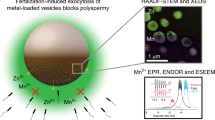Abstract
THE prevention of polyspermy in the sea urchin egg is a two-stage process: a rapid reduction in the chances of refertilisation—the ‘fast block’1,2, which seems to be electrical in nature3—and a slower block that coincides with elevation of a morphological barrier, the fertilisation membrane. The fast block has many features in common with the action potential of excitable tissues, while elevation of the fertilisation membrane seems to involve a classical exocytotic reaction similar to that found at nerve terminals. Lying immediately beneath the plasma membrane of unfertilised eggs is an array of vesicles called cortical granules each about 1 µm in diameter. Shortly after fertilisation the contents of these granules are expelled, the granule membrane becoming incorporated into the plasma membrane of the egg. The trigger for initiating the cortical reaction seems to be a rise in intracellular ionised calcium. Thus granule release can also be promoted by the ionophore A23187 (ref. 4) and measurements in aequorin-loaded fish and sea urchin eggs5,6 show that exocytosis brought about by both sperm and ionophore is associated with a rise in intracellular ionised calcium. The mechanism of exocytosis in any system is unknown and the cortical granule reaction in sea urchin eggs seems to provide an excellent experimental preparation for its investigation. Here we examine the influence of metabolic poisons and calcium on the cortical reaction. In the presence of ATP exocytosis is activated by micromolar concentrations of calcium; but in the nominal absence of ATP the exocytotic process slowly becomes refractory to calcium.
This is a preview of subscription content, access via your institution
Access options
Subscribe to this journal
Receive 51 print issues and online access
$199.00 per year
only $3.90 per issue
Buy this article
- Purchase on Springer Link
- Instant access to full article PDF
Prices may be subject to local taxes which are calculated during checkout
Similar content being viewed by others
References
Rothschild, Lord & Swarm, M. M. J. exp. Biol. 27, 400–406 (1952).
Presley, R. & Baker, P. F. J. exp. Biol. 52, 455–468 (1970).
Jaffe, L. A. Nature 261, 68–71 (1976).
Steinhardt, R. A. & Epel, D. Proc. natn. Acad. Sci. U.S.A. 71, 1915–1919 (1974).
Ridgway, E. B., Gilkey, J. C. & Jaffe, L. F. Proc. natn. Acad. Sci. U.S.A. 74, 623–627 (1977).
Steinhardt, R. A., Zucker, R. & Shatten, G. Devl. Biol. 58, 185–196 (1977).
Okazaki, R. Expl. Cell Res. 10, 476 (1956).
Bergmeyer, H. V. in Methods of Enzymatic Analysis (transl. Williamson, D. H.) (Academic, New York, 1965).
Zimmerman, U., Reimann, F. & Pilwot, G. Biochim. biophys. Acta 394, 449 (1975).
Baker, P. F. & Knight, D. E. J. Physiol., Land. 284, 30P (1978).
Sillen, L. G. & Martell, A. E. Stability of Metal Ion Complexes (Chem. Soc. Special Publ. No 25, 1971).
Vacquier, V. D. Devi Biol. 43, 62–74 (1975).
Mazia, D., Schatten, G. & Sale, W. J. cell. Biol. 66, 198 (1975).
Endo, M. Physiol. Revs. 57, 71–108 (1977).
Author information
Authors and Affiliations
Rights and permissions
About this article
Cite this article
BAKER, P., WHITAKER, M. Influence of ATP and calcium on the cortical reaction in sea urchin eggs. Nature 276, 513–515 (1978). https://doi.org/10.1038/276513a0
Received:
Accepted:
Issue Date:
DOI: https://doi.org/10.1038/276513a0
This article is cited by
-
Enhancement of the Ca2+-triggering steps of native membrane fusion via thiol-reactivity
Journal of Chemical Biology (2009)
-
Ionic and permeability requirements for exocytosis in vitro in sea urchin eggs
The Journal of Membrane Biology (1988)
-
Exocytosis reconstituted from the sea urchin egg is unaffected by calcium pretreatment of granules and plasma membrane
Bioscience Reports (1988)
-
An appreciation of Peter Baker
The Journal of Membrane Biology (1988)
-
How calcium may cause exocytosis in sea urchin eggs
Bioscience Reports (1987)
Comments
By submitting a comment you agree to abide by our Terms and Community Guidelines. If you find something abusive or that does not comply with our terms or guidelines please flag it as inappropriate.



